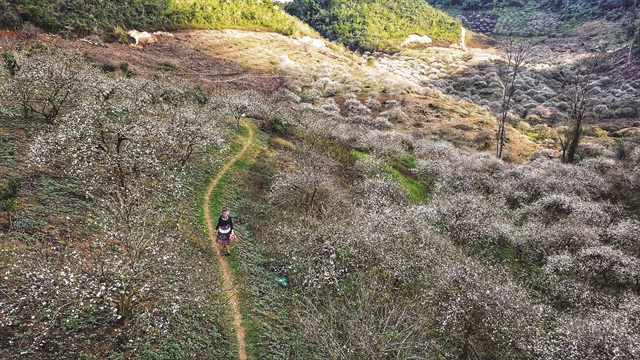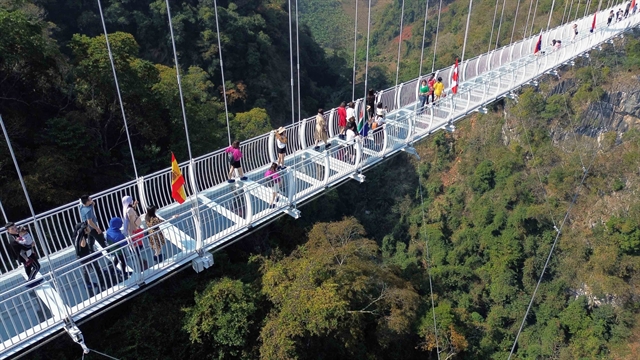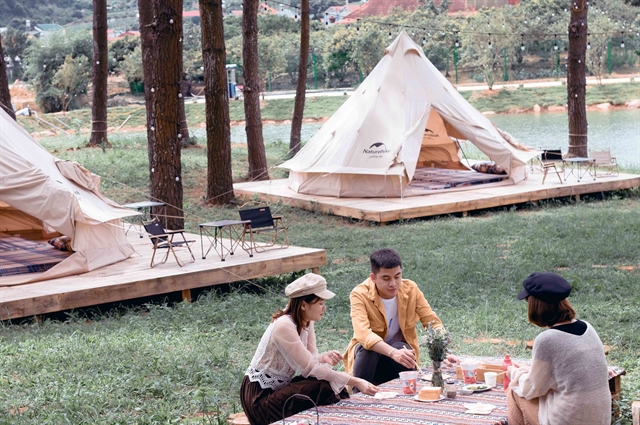Weather:
- Ha Noi 33oC
- Da Nang 30oC
- Ho Chi Minh 33oC

Endowed with a majestic natural landscape, year-round cool climate and abundant natural tourist attractions, Mộc Châu District in the northern mountainous province of Sơn La has been dubbed as the "green pearl" of the northwest region.
The district, about 200km from central Hà Nội and at an altitude of over 1,000m, is a must-visit destination for those who love nature and seek inner peace among the vast mountains and forests.
Recently, the natural beauty of Mộc Châu has become a star of the global tourism map, with the locality crowned as 'Asia's Leading Regional Nature Destination' and the 2022 World Travel Awards.
“Such awards were not only an honour but also important for the district to promote its cultural and natural values, affirming its place on the world tourism map,” said Chairman of Mộc Châu District People's Committee Lê Trọng Bình.

Mộc Châu is the gateway to the northwest, and the stopover for inter-regional tours such as Hà Nội - Sơn La - Điện Biên Phủ - Sa Pa - Lào Cai; and the transnational tourism routes such as Hà Nội - Sơn La - Luang Prabang (Laos) - Thailand; and Sơn La - Lai Châu - Yunnan (China).
The district is one of the biggest plateaus in the country, stretching some 80km long and 25km wide, and stands about 1,050m above sea level.
Its average temperature is 20 degrees Celsius. In the winter, from Pha Luông and Mt Vân Hồ, visitors can view the beautiful 50,000-ha plateau through a thick fog.
It charms tourists with many beautiful and unique natural landscapes such as majestic Mt Pha Luông, poetic Dải Yếm Waterfalls, and Dơi Cave with its magnificent natural stalactite system.

Mộc Châu is also known as a land of flowers. Any time of the year, visitors can admire the beautiful flowers in bloom. The region’s scenic beauty is at its best during late winter and early spring when apricot, plum and peach blossoms begin to fully bloom, creating a picturesque scenery that charms visitors at first sight.
The system of archaeological sites along the Đà River includes the Tạng Mè burial cave, animal fossils at Chiềng Yên, and the ancient carved stone of Xuân Nha, as well as other historical sites. Moreover the district also boasts many hot springs.
Mộc Châu is home to 12 ethnic groups whose culture identities have been actively preserved by the local authorities through many festivities, like the Ethnic Culture Festival from August 30 to September 2, the Rain Praying Festival in March, and a fruit picking festival in May.

According to the Việt Nam Tourism Development Strategy, the Mộc Châu National Tourism Area, including Mộc Châu and Vân Hồ districts, has been evaluated as a key national tourist centre in the northern midlands and mountainous region.
The Mộc Châu National Tourism Area forms three key tourist centres: Mộc Châu Resort Centre, Mộc Châu Ecotourism Centre, and Mộc Châu Amusement Centre.
The tourism infrastructure and services in the area has received investment and been improved in recent years to meet the needs of numerous tourists from home and abroad.
In 2022, Mộc Châu received over 1.5 million visitors, earning over US$72 million from tourism. In January alone, tourists to the district were estimated at 225,000, generating a revenue of $10 million.
Many tourism programmes have been launched to connect pristine community-based tourist attractions like Áng Village, Dọi Village, Vặt Village in Mộc Châu; and Phụ Mẫu Village or Hua Tạt Village in Vân Hồ. Within the programmes, participants can experience eco-agriculture tourism in the fields, growing tea or conquer majestic Mt Pha Luông.
“The natural beauty of Mộc Châu District has enticed me to come again,” said Đỗ Thị Huyền from Hà Nội, who visited the region in early February.
“We particularly enjoyed tasting delicious local food by the murmuring streams and among the forests. We felt like we were lost in a fairyland when visiting the white plum blossom forest."
“Tourism here is increasingly better. The local food is really delicious and there are many restaurants and hotels that can cater to different kinds of tourists,” she added.
Tourism development in the district goes hand-in-hand with the preservation of local cultural identity. Many travel agencies and businesses have properly exploited the nature landscape and culture to launch various types of cultural and ecotourism products, in an effort to build the image of Mộc Châu as a hospitable destination.
Many tourism products have attracted domestic and international tourists, such as the Bạch Long glass bridge in Mộc Châu Island Park and Resort, which is the world’s longest bridge of its kind; the pine forest tourist area in Áng Village, community-based tourism in Dọi, Vặt or Tà Số villages.
"The operation of the tourist site is closely associated with nature to maintain the title as top regional destination," said Hoàng Mạnh Duy, the head of Sales Department of Mộc Châu Island Park and Resort.
"Therefore, preserving the landscape is one of the prerequisites that we aim to achieve." Duy added.
According to Chairman of Mộc Châu District People's Committee Lê Trọng Bình, the locality conducts many activities to live up to its international recognition.
"Mộc Châu has planned and preserved tea plantations, grasslands, and forest to maintain the natural landscape. In the development of community-based, agricultural and nature tourism, environmentally friendly materials associated with ethnic cultural identities will be prioritised as a highlight of the district," he said.
"The district is also focusing on making a master plan for tourist routes and spots to 2025, stepping up investment and tourism promotion, thereby attracting more and more investors and tourists."
Mộc Châu is set to serve over 2.9 million holidaymakers by 2030, earning a revenue of about $265 million. VNS


